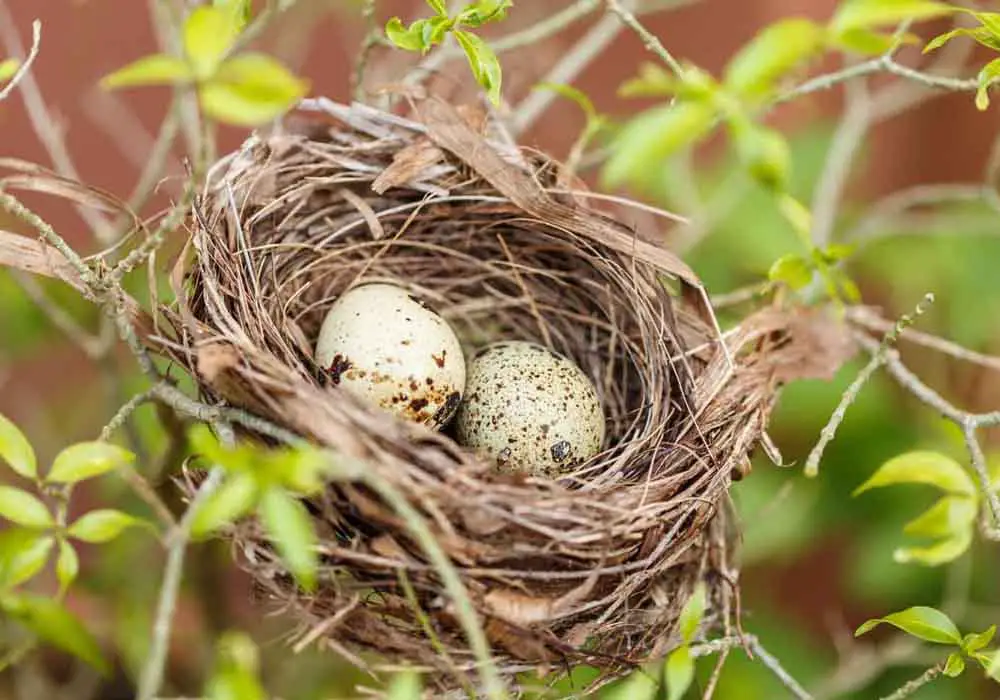12 Fun Facts About Bird Eggs
Bird eggs are one of the fascinating things about birds’ anatomy and biology. On top of that, many things are still being discovered about birds' eggs, from shell pigmentation to egg sizes. Apart from the “sciency” stuff, there are so many fun facts about bird eggs.
Some birds can lay about 15 eggs per clutch, such as grey partridge, while many others lay only one. Additionally, some birds lay blue eggs, which leaves oologists guessing about the reason behind the coloring, with some suggesting it’s a sign of a better-developed egg.
If you want to know more fun facts about bird eggs, continue reading this article. You’ll learn everything from “brood parasites” to egg thieves.

1. Most Birds Lay Eggs Continually
Many people usually think that birds lay eggs only when they’re having their baby birds, or perhaps once in a blue moon.
The fact is, most birds lay their eggs on a continual “schedule.” Songbirds, in particular, for instance, usually lay eggs on a daily basis - and still, they find time to amuse us with their beautiful voices.
With smaller birds, the entire process of producing an egg (or more than one) lasts about a day, so they’re basically small egg-producing machines that never stop. And no, a female bird doesn’t need a male companion to produce eggs.
2. Albatrosses Take Their Sweet Time To Lay Eggs
Okay, so the opposite of those small songbirds are albatrosses. They’re not really into the whole laying-eggs-daily business (honestly, who could blame them). Laysan Albatrosses are one of those birds that mate for life and follow a strict biological cycle when it comes to breeding.
So, Laysan Albatrosses lay only one egg in an entire year. However, that’s not all. These birds usually lay an egg every two years! So, they generally produce one egg in two years, after which the male albatross incubates the egg while the mommy bird is recovering someplace far away - good for her.

So how often do birds lay eggs? Once a month? Three times a year? Well, this depends upon the bird. See what we mean by checking out our How Often Do Birds Lay Eggs article here.
3. Kiwis’ Eggs Are Massive
When we think about birds that lay really big eggs, we usually think of ostriches, and yes, we’d be right - in a way. However, we most definitely wouldn't think about kiwis, you know, those tiny birds that look like, well, kiwi fruit.
They probably don’t lay eggs that are almost as big as their entire body, right? Wrong! That’s precisely what they do. While kiwi’s eggs aren’t the most massive, they are the biggest when compared to the kiwi’s body. The egg weighs about 15% the amount of the average kiwi weight.
The size of a kiwi’s egg means that basically, when the egg hatches, the baby kiwi is almost entirely developed and ready to walk.
4. Some Birds Leave Their Eggs in Other Birds’ Nests
Parenting can be difficult, and some species of birds understand that. So much so that some birds are ready to place their eggs into other birds’ nests. This is called “brood parasitism,” and it’s when an animal (a bird in this case) leaves its baby with another animal of the same (or different) species to take care of it.
Unfortunately, the whole business of putting eggs into other birds’ nests doesn’t always go according to plan. Most birds, especially if there’s a difference in the color of the eggshell, notice if an egg doesn’t belong to them, and they simply toss the egg from the nest.
5. Bird Eggs Are Porous
This one might sound crazy, but bird eggs have microscopic pores all over the eggshell. I’m sure you have so many questions right now. Well, let me answer the most obvious ones.
Liquids in the egg can’t go through those pores because there’s a thin, transparent layer of membrane that keeps everything compacted together. Now, to answer the second question: why? Bird eggs are porous because that allows fresh oxygen to enter the egg.
Oxygen’s the life force that keeps a baby bird alive but also fills the space between the membrane and the eggshell. In time, that pocket of oxygen will enter a chick’s lungs, and it’s because of this that it can start cracking the eggshell open.
Here's a fascinating You Tube video on how oxygen
gets inside of birds eggs...
6. Bird Eggs Can Chirp?
Imagine you stumble upon a nest, and you notice a couple of eggs ready to be hatched. Then you hear some muffled chirping but don’t see any birds, and you realize the sound’s coming from the eggs. How is this possible? Well, believe it or not, some eggs can chirp - okay, not eggs but birds inside those eggs.
You can hear chirping inside the eggs in the period before chicks start to hatch (usually the last couple of days). That’s because chicks are almost completely developed up to that point. That’s when the chirping and the actual hatching (as in the cracking of the egg) start.

Can birds lay eggs without a male? If so, how does that work?? Here's an interesting article we wrote that will answer this in much greater detail.
7. You Can Tell if There’s a Bird Inside an Egg
First, let me say: don’t shake the egg - that’s not how this works! Now, it is possible to tell if there’s a tiny chick inside the egg. However, this is easier as the hatching period gets closer.
One of the best ways to tell if a chick is inside is to place the egg in front of some bright light source. Lamps and candles are good for this, but be careful with candles.
When you do so, you’ll be able to see small veins throughout the egg. Those veins are there to provide the chick with everything it might need to survive, including oxygen passing through the pores in the eggshell. The egg operates in much the same way as a human womb, and it’s crazy that you can actually see it before your eyes.
8. Bird Eggs Can’t Survive Long Without Heat
Have you ever wondered why birds spend all that time sitting on their eggs? Sure, it’s partly to protect the precious life stored in those eggshells, but a more important reason is to provide heat for their babies. This is something we, as humans, can relate to since we, too, need to provide a heat source for our babies.
Those eggshells offer some form of incubation and protection, but they’re not a heat source in any way. As we know by now, eggshells have tiny pores that cold air can pass through easily. Unfortunately, if there’s no continual heat source, the chick inside the egg can die in only a matter of hours.
9. The Color of an Egg Is Related to Temperature
Eggs generally have two main pigments - brown and blue. From these two pigments, we get numerous color combinations and hues. For the longest period, scientists weren’t sure why some eggs were bluer than others.
There was a “Blackmail Hypothesis” that suggested that the depth of color meant a better quality of the egg, and because of that, the male parent would take more care of that egg than the others.
Recently, however, scientists noticed a connection between egg color and temperature. More brownish eggs are usually found in colder places and retain heat better, while blue and green eggs are more prevalent in tropical places.
10. The Oval Shape of the Eggs Provides More Protection
Egg shapes are pretty much universal, unlike some other qualities, such as size. We generally think that eggs appear in this particular shape because it’s easier for a bird to, well, “deliver it.” While there might be some truth to that, the oval shape is there for another reason.
The oval shape provides better protection for the chick inside because it’s harder to break in certain areas. Remember that popular trick a few years ago where people grabbed an egg and tried to break it with their hand but couldn't? It’s the shape, everyone. fun facts about bird eggs
Also, imagine a completely round egg. It would just roll away as soon as it hit the ground (unless it broke), but the oval shape gives it a unique boomerang trajectory which means it can start rolling and make a circle back to where it was. It’ll need to wait a little more to leave its parents’ home.

What's inside a bird egg? It's amazing to think a well formed chick can come out of what's there. Here's an article of ours that you'll enjoy...no yolk!
11. The Grey Partridge Lays the Most Eggs
Okay, grey partridges aren’t exactly the most memorable when it comes to their looks or their name. However, they still have some bragging rights, especially female grey partridges. That’s because they lay 15 eggs per clutch on average (clutch means the number of eggs in total for one nesting). That’s impressive, especially after what we learned about albatrosses.
Most birds lay one or two eggs, and there are some with a higher number, but no one can beat a grey partridge. As I said, 15 eggs per clutch is an average, but some partridges lay as many as 20 or more. They sure are eager to keep that record for themselves, and who could blame them with a name like that?
12. Some Birds Are Egg Thieves
Although there are many animals that prey on bird eggs, you generally wouldn’t expect another bird to be among those. However, some breeds, especially corvids (like crows, jays, or magpies), are all up for some proper egg thieving.
It kind of makes sense when you think about it, I guess. Who would know all the perfect places for nests if not birds themselves?
Fun Facts About Bird Eggs...Final Thoughts
As you can see there's lots of fascinating fun facts about bird eggs that most have never heard of. And who would have thought that eggs themselves would be as diverse in size, shape and colors as birds themselves?
Considering that there's about 11,000 bird species globally, were sure we missed a few egg facts ourselves.
Back To The TOP Of This Fun Facts About Bird Eggs Page

About the Author...
Richard Worden, a dedicated bird lover for over 20 years, I love to share my in-depth knowledge and passion for birds. Read more About Me and my expertise in this field.
- We Know Birds HOME ›
- Bird Egg Facts and Information ›
- Fun Facts About Bird Eggs
